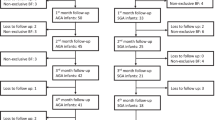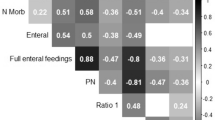Abstract
Growth and development of 100 term SFD infants divided into 3 groups with body weight of 1·5 kg or less (I), 1·51–1·75 kg (II), 1·76–2·25 kg (III) and 100 AFD term infants was determined longitudinally. Group I and II infants remained smaller and had delayed milestones of development throughout the 1st year of life, with limited catch up only in body weight in the first 3 months. Their milk intake was low (132 ml/kg). Group III infants, who had comparatively better growth parameters at birth, showed effective catch up growth in all the parameters to reach the level of those of AFD infants within 3–10 months by increased consumption of milk (186 ml/kg). Their milestones of development were at par with that of AFD infants who consumed 160 ml of milk/kg/day in the first 2–4 months. The low consumption of milk by group I and II infants with severe intrauterine malnutrition is possibly related to the reduced appetite geared to a small body size.
Similar content being viewed by others
References
Khatua SP, Manocha BK, Sukanta Chatterjee, Roy Polodhi PK. Incidence and etiology of SFD infants.Indian Pediatr 1979;16: 395–402
Datta Banik ND. A study on incidence of different birth weight babies and related factors.Indian Pediatr 1978;15: 327–331
Davies DP, Platts P, Pritchard JM, Wilkinson PW. The nutritional status of light for dates infants at birth and its influence on early postnatal growth.Arch Dis Child 1979;54: 703–706
Cassady G. body composition in intrauterine growth retardation.Pediatr Clin North Am 1970;17: 79–85
Davies DP. Size at birth and growth in the first year of life of babies who are overweight and underweight at birth.Proc Nutr Soc 1980;39: 25
Campbell S. Physical methods of assessing size at birth. In:Size at birth. New York: Associated Scientific Publishers. 1974, p 275–293
Dobbing J.The later development of the brain and its vulnerability. Scientific Foundation of Pediatrics, 2nd ed., Ed. JA Davis, J. Dobing. William Heinemann Med Book Ltd., London 1981, p 744–758
Dubowitz LM, Dubowitz MS, Cissile V. Clinical assessment of gestational age in the new born.J Pediatr 1971;77: 1–10
Miller HC, Hassanein K. Diagnosis of impaired fetal growth in new born infants.Pediatr 1971;48: 511–522
Babson SG. Growth of low birth weight infants.J Pediatr 1970;77: 11–18
Fancourt R, Campbell S, Harvey D, Norman AP. Follow up study of small for dates babies.Br Med J 1976;1: 1435–1437
Bhargava V, Ghose Shanti, Bhargava SK. Survival, growth and development in babies weighing 2000 gms or less.Indian Pediatr 1970;7: 139–145
Srivastava AK, Agarwal VK, Gupta SK. A longitudinal study of physical growth and morbidity pattern of SFD babies from birth to six months of age.Indian J Pediatr 1979;45: 1–10
Kalra SK, Sarkar P, Vatwani V, Dey NC. A longitudinal study of low birth weight babies.Indian J Pediatr 1983;50: 279–283
Widdowson EM.Immediate and long term consequences of being large or small at birth Ciba foundation symposium 27. New York: Associated scientific Publishers, 1974, p 65–76
Dorner G, Standt, J. Vergeeichende morphologisch Untersuchungen der Hypothal amusdifferenzierung der Ratte Und Mensche.Endokrinologie 1972;59: 152–157
Beck GJ, Vandenberg BJ. The relationship of the rate of intrauterine growth of low birth weight infants to later growth.J Pediatr 1975;86: 504–511
Bjerre 1. Physical growth of 5 yr old children with a low birth weight.Acta Ped Scand 1975;64: 33–37
Babson SG, Kangas J, Young N. Growth and development of twins of dissimilar size at birth.Pediatrics 1964;33: 327–333
Weiner G, Rider RV, Oppel WC. Correlates of low birth weight; psychological status six to seven years of age.Pediatrics 1965;35: 434–444
Neligan GA. The clinical effects of being light for dates.Proc Roy Soc Med 1967;60: 881–883
Ounsted MK, Sleigh, G. The infants self regulation of food intake and weight gain.Lancet 1975;i: 1393–1397
Davies DP.Growth and nutrition in low birth weight infants. MD Thesis, University of Wales 1976
Manlan G, Scott KE. Contribution of twin pregnancy to perinatal mortality and fetal growth retardation.Can Med Assoc J 1978;1183: 365
Mc Neish AS, Ducker DA, Warren LF, Davies DP, Hughes CA. The influence of gestational age and size on the absorption of D-xylose and D-glucose from the small intestine of human neonates. Ciba foundation symposium. Associated scientific Publishers New York 1980, pp 267
Author information
Authors and Affiliations
Rights and permissions
About this article
Cite this article
Khatua, S.P., Saha, D., Khatua, S. et al. Early growth of term SFD infants in relation to caloric intake. Indian J Pediatr 54, 695–701 (1987). https://doi.org/10.1007/BF02751283
Issue Date:
DOI: https://doi.org/10.1007/BF02751283




